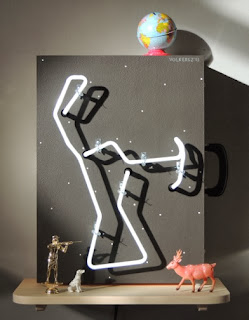After my family moved from Holland to Seattle when I
was a teenager, I began exploring the West, camera in
hand,
documenting a vibrant culture of billboards, vernacular
architecture, and
hand-painted mailboxes. Over time,
I became
increasingly fascinated with popular culture: larger-than-life
advertising figures, neon signs and tourist souvenirs.
Ultimately, after art and architecture studies at the University of Washington and an MFA at Mills College, these experiences became part of my visual vocabulary.
Now, as I travel, I stop at second hand stores and antique
malls and buy objects (often the kind that decorated our grandmothers' homes): ceramic
birds and dogs and other small objects.
Birds of North America (2005) mimics Audubon’s famous compendium, except that here they are really birds of North American junk stores.
Other objects have more personal meaning to me, like a
small, bronze Statue of Liberty or a souvenir Empire State Building--reminders
of my first days in the US. Travel
souvenirs abound and I pick up postcards, metal ashtrays in the shape of
states, and globes.
Often, these objects help to illustrate a story. In Western
Landscape (2007), objects on a shelf below the painting comment on both the
beauty as well as the rapid urbanization of the West.
Postcards
and globes help to tell stories of travel and adventure, as in Selfportrait (Baggage) (1991-2005).
In the recent series Short
Stories, I explore the potential of small, suitcase-sized sculptures each
of which contain a painting, an iconic neon image, and found objects. In Orion
the Huntress (2013), I continue an ongoing theme in which I explore the
constellations while in another (Vincent
in Paris, 2013) I return to my fascination with the life of Vincent van
Gogh, whose work was much in evidence when I visited museums in Amsterdam as a
boy.
In my slide lecture, I will show numerous examples of my
work and the roadside culture that fascinates me and talk about the evolution of
my use of found objects, the themes in my work, the process of collecting and
my working methods.
--Willem Volkersz
2014 Yuma Symposium Presenter























